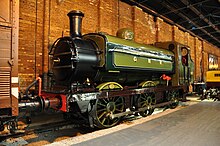Switcher locomotive
This article needs additional citations for verification. (January 2023) |
A switcher locomotive (
Switchers are optimized for their role, being relatively low-powered but with a high starting tractive effort for getting heavy cars rolling quickly. Switchers are geared to produce high torque but are restricted to low top speeds and have small diameter driving wheels. Switchers tend to be durable and to remain in service for a long time,[4] such as the Swedish class U.
American, Russian, Indian and Chinese switchers tend to be larger, with
Etymology
A switcher may also be called a yard pilot, switch engine, or yard goat.
The term can also be used to describe the workers operating these engines or engaged in directing shunting operations. Switching locomotives may be purpose-built engines, but may also be downgraded main-line engines, or simply main-line engines assigned to switching. Switchers can also be used on short excursion train rides.
Power types
Diesel

Modern diesel switchers are usually
Electric

The majority of modern switchers are diesels, but countries with near-total
, not far from where it was built.Small industrial shunters are sometimes battery powered type. An early battery-powered shunting locomotive is shown here.[5] The Tyne and Wear Metro has three battery electric shunters built by Hunslet, which are used to haul engineering trains when the overhead supply is switched off. New Zealand Railways imported and manufactured locally battery-electric shunters in the 1920s: the EB class and the E class (1922)
Electro-diesel

Some switchers are electro-diesel, and hence can be powered from onboard diesel engines, or from an external electricity supply.
Steam

Steam shunter/switchers are now mostly out of service.
As diesel shunters began to appear in ever-increasing numbers, attempts were made by companies such as Sentinel to adapt the vertical boilers from their steam powered road vehicles for use in shunting locomotives, in order to compete with the newcomers. Although these were found to be equal in power and efficiency to most of the early diesel designs, their development came too late to have any real impact. Outwardly, they bear more resemblance to diesels than steam locomotives. A number have been preserved on heritage railways, although few of these are in working order, being designed very specifically for shunting work and lacking the necessary speed to travel any kind of distance.
Small industrial shunters have sometimes been fireless locomotives and a few of these are still at work in Germany. Again, several have been preserved, but are mostly static displays, as heritage railways and museums lack the large source of high-pressure steam (such as a power station's boilers) needed to charge the locomotive's accumulator.
By region
United States

American switchers tend to be larger, and are almost always powered by diesel.
Most American switchers are actually road switchers, which are larger and have greater power output, to be used on mainlines.
Great Britain

British shunters are much smaller than those used in the United States. Current British shunters are
Continental Europe

In continental Europe 0-6-0 (or "C") diesel-hydraulics, similar to the short-lived British Rail Class 14, are widely used. A very common type is the DB Class V 60 and its variants. For lightweight shunting of single wagons or short trains, two-axle shunters are common; in Germany these are known as Kleinlokomotive (small locomotive).
See also
- Road switcher
- Road-rail vehicle
- Railcar mover
References
- ^ Burns, Adam (29 December 2022). "Switcher Locomotives: An Overview". US. Retrieved 2 February 2023.
- ^ "New California Locomotives Designed to Reduce Emissions". UP. Retrieved 13 February 2023.
- ^ "Cummins Develops Option to Help Switcher Locomotives Reduce Emissions". Finance.yahoo.com. 2 December 2021. Retrieved 13 February 2023.
- ISBN 9781627883979.
- ^ "Electric locomotive, 1917". Ingenious. UK. Archived from the original on 28 March 2016. Retrieved 14 May 2016.


